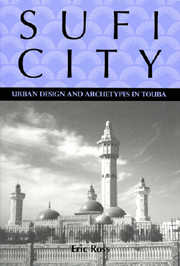Book contents
- Frontmatter
- Contents
- List of Illustrations
- List of Appendixes
- Acknowledgments
- Note on Translation, Spelling, and Transliteration
- Introduction
- 1 Archetypes: Sufi Phenomenology and the Semiosis of Landscape
- 2 Urban Design: The Spatial Configuration of a Spiritual Project
- 3 Marabout Republics Then and Now: Autonomous Muslim Towns in Senegal
- 4 The Pénc: Trees and Urban Design in West Africa
- Conclusion
- Appendix 1
- Appendix 2
- Appendix 3
- Appendix 4
- Appendix 5
- Appendix 6
- Appendix 7
- Notes
- Bibliography
- Index
- Rochester studies in African History and the Diaspora
Conclusion
Published online by Cambridge University Press: 12 September 2012
- Frontmatter
- Contents
- List of Illustrations
- List of Appendixes
- Acknowledgments
- Note on Translation, Spelling, and Transliteration
- Introduction
- 1 Archetypes: Sufi Phenomenology and the Semiosis of Landscape
- 2 Urban Design: The Spatial Configuration of a Spiritual Project
- 3 Marabout Republics Then and Now: Autonomous Muslim Towns in Senegal
- 4 The Pénc: Trees and Urban Design in West Africa
- Conclusion
- Appendix 1
- Appendix 2
- Appendix 3
- Appendix 4
- Appendix 5
- Appendix 6
- Appendix 7
- Notes
- Bibliography
- Index
- Rochester studies in African History and the Diaspora
Summary
This study of Touba has revolved around two key questions. How does Sufism relate to urbanization and urban design? How do the contemporary Sufi urban processes in Senegal relate to modern urban processes? Recourse to a Sufi phenomenology was adopted to answer these questions. By looking at the world through Sufi eyes, with a mind equipped with Sufi concepts and methods, the agency of individual Sufi masters and of Sufi institutions can be explained.
Sufism postulates multiple layers of reality. The material world is not complete in and of itself. Matter is inert and purposeless. It has no intrinsic meaning. Matter is relevant to life only insofar as it is infused with some part of the Divine. God wills the contingencies of generation and corruption through which matter acquires meaning. The essential truth of things resides in God, beyond (and before) any perceptible or knowable expression or manifestation. Truth, which is “one” in God, is discernible through an analysis of multifarious manifestations of things in the material world. This analysis relies on both the faculties of the intellect and of the imagination. The imaginative faculty makes extensive use of metaphor and symbols. Some of these symbols, those that constitute ideal forms such as the tree, have been referred to in this study as archetypes. By using the active intellect and the active imagination, Sufis analyze the perceptible world to discover the essential truth of things.
- Type
- Chapter
- Information
- Sufi CityUrban Design and Archetypes in Touba, pp. 216 - 220Publisher: Boydell & BrewerPrint publication year: 2006



